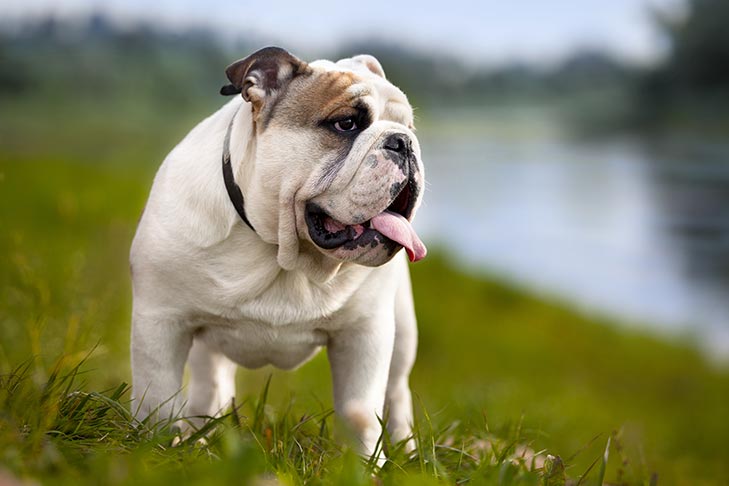Connect with a verified veterinarian in minutes. Licensed vets are available 24/7 to answer your questions. No need to worry about your furry family member.
There are many dog breeds in the world, and it can be confusing to tell them apart. Especially when they strongly resemble one another, like the American Bulldog and the American Bully. Can you tell them apart?
We’ve put together some information about the differences between the American Bully and the American Bulldog. We hope that by the end of this article, you’ll be able to tell these dogs apart! Let’s get started!
American Bully and the American Bulldog
Did you know that the American Bully and the American Bulldog are two separate dog breeds? It’s easy to mistake them for one another. Both dogs look very similar. And sometimes, these dogs are also confused with American Pitbull Terriers (also called Pitbulls).
Here’s a quick overview of the history of both dog breeds.
The American Bully
The American Bully is a younger dog breed than the American Bulldog. These dogs were developed in the US in the 1980s. They were bred to be a more friendly, family version of the American Pitbull Terrier. Breeders bred American Staffordshire Terriers, American Pitbull Terriers, American Bulldogs, English Bulldogs, Olde English Bulldogges, Staffordshire Bull Terriers, and French Bulldogs to achieve the American Bully dog breed.

Review symptoms, medications & behavior to keep your pets healthy with a Vet Online in just minutes.
Ask a Vet Live NowThe American Bulldog
The American Bulldog is thought to be older than the American Bully breed. They’re descended from the Old English Bulldog (which is extinct). The Old English Bulldog was originally brought to the US by immigrants from England in the 1600s. The dogs were used for hunting and protecting property & livestock. The dogs had to be large and strong for this kind of work.
Appearance
Both dogs are large, though the American Bulldog is a little larger. American Bulldogs usually stand between 19 to 26 inches tall and weigh up to 120 lbs. On the other hand, the American Bully usually stands between 13-20 inches tall and weighs up to 110 lbs.
Both dog breeds have square-shaped heads and muscular bodies; however, the American Bully usually is more muscular. They look like a large Pitbull that has been pumped with steroids. What’s more, the American Bully comes in four different recognized sizes, including standard, classic, extra large (the largest), and pocket (the smallest).
On the other hand, the American Bulldog looks more like an English Bulldog, with its loose, wrinkly skin. The dogs have a powerful, broad chest; however, they don’t have the same heavy muscles as the American Bully.
Both dog breeds have short, smooth coats that come in a broad range of colors and markings.
Temperament
Both dogs breeds should be trained and socialized from a young age because they’re both strong dogs that can be very determined.
The American Bulldog is an active dog that loves to have fun. However, they can also be stubborn and tough. For this reason, the dogs are not recommended for inexperienced pet parents. American Bulldogs do best with pet parents who can be firm and consistent with training.
The American Bulldog can look pretty scary; however, they’re actually very gentle and tend to be loyal to their families.
On the other hand, the American Bully is a highly intelligent, loyal, and loving family companion. However, the dogs are also very powerful. These dogs are sometimes used as watchdogs because they are very protective. They also need to be trained and socialized from their puppyhood on.
Both dog breeds are very active and need plenty of exercise. They also make great working dogs and enjoy being given a job to do. The American Bull also enjoys dog sports and competitions.
Health
When it comes to health, the American Bulldog is prone to joint and spinal issues, including hip dysplasia, thyroid issues, and kidney problems. They can also suffer from cataracts, mange, and more. This dog breed loves to eat. If they don’t get plenty of exercise every day, the American Bulldog can easily become obese.
The American Bully is still a relatively new dog breed, so there’s not a lot of information on the health of these dogs. Some American Bulldogs seem to be very healthy, while others suffer from various health problems. Some develop hip dysplasia, congenital heart issues, skin conditions, and eye problems.
Both the American Bully and the American Bulldog share some health issues, including NCL, cherry eye, entropion, and bone cancer. In addition, both dog breeds are moderately brachycephalic (they have short snouts). This condition can cause breathing problems for the dogs, especially in hot weather.
When it comes to life expectancy, the American Bulldog has a bit longer life span of 14 to 16 years, while the American Bully’s life expectancy is 8 to 12 years.
Training & Exercise
When it comes to training and exercise, these dog breeds also have their own needs. For instance, the American Bully is highly intelligent and learns fast. They respond best to positive reinforcement training methods.
These dogs love to walk, jog and enjoy agility and other competitions.
American Bulldogs are also highly energetic dogs that love to play. They need at least 30 to 40 minutes of exercise a day. The dogs enjoy running, walking, agility, and more.
When it comes to training, the American Bulldog can be a little more stubborn. Pet parents need more patience and should be consistent in training their dogs.
Are American Bullies or American Bulldogs Dangerous?
Both dog breeds are muscular and strong. And they love to play; however, American Bulldogs can become overly excited and play more roughly. This can lead to injuries. However, the dogs are not aggressive.
The American Bulldog is very loyal to his family and is very protective of his home and humans. They make excellent watchdogs and will do what’s necessary to stop intruders.
On the other hand, the American Bully has been bred not to be aggressive. So, these dogs are gentle and calm. They are not dangerous to kids.
The main takeaway here is that any dog breed can be dangerous. This is why training and socialization are essential from the time dogs are puppies and into their adult years.
Summing It Up
So, there you have it! The American Bulldog and the American Bully are very similar dogs in many ways. They both resemble one another and can be silly, fun dogs that love their pet parents and families.
However, both are completely different dog breeds. Each one can make an amazing family companion and are best for active families who can commit to spending plenty of time training, socializing, and loving these unique but similar dog breeds.
Connect with a verified veterinarian in minutes. Licensed vets are available 24/7 to answer your questions. No need to worry about your furry family member.

Kim
Kim is a talented author, who loves animals especially dogs. She engaged in writing books and articles relating to animals a decade ago. Kim resides in Chicago with her husband and son. The family is the proud owner of a dog and a parrot (Jack and Lily). Kim wanted more than these two pets, but her husband put his foot down... She often visits elementary schools to talk to the kids about what she learned about pets and how they could learn from them.
Review symptoms, medications & behavior to keep your pets healthy with a Vet Online in just minutes.
Ask a Vet Live Now




